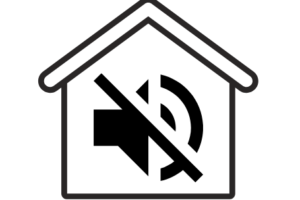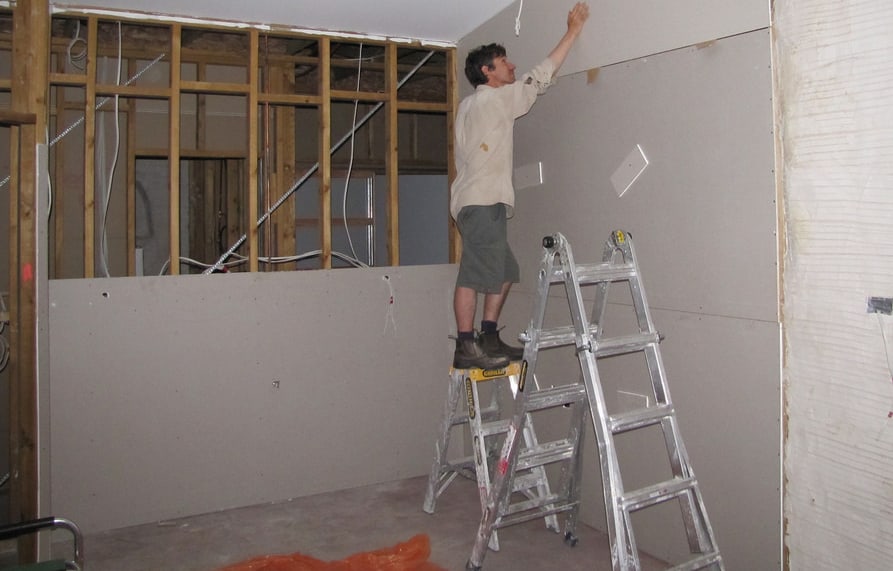If you are looking to soundproof your walls, acoustic plasterboard, as the name suggests, is the better option when compared to normal plasterboard. The difference lies in the fact that acoustic plasterboard is thicker, has more mass(may even be reinforced with special additives) and hence, stops more noise.
A funny thing to note is that what most Europeans call as plasterboard is called drywall or gypsum board or even sheetrock(which is a popular brand) in the US. It’s one and the same, however.
What Is Plasterboard?
Plasterboard(or drywall) is nothing but gypsum sandwiched between layers of paper which are chemically and physically bonded to it.
There are several variants of plasterboard, apart from normal plasterboard, such as:
Fire resistant plasterboard
While plasterboard is inherently quite fire resistant, there are a few specially made plasterboard products, that enhance this property- for cases where really stringent fire protection is required.
You probably don’t need it for your homes, though, as plasterboard contains crystalline water molecules and so, will burn only at a really high temperature.
Moisture resistant plasterboard
Placing normal plasterboard inside the kitchen or bathroom- or any place where moisture content is high- is a bad idea. You’ll need some specially made moisture resistant plasterboard, such as this one which is enhanced with silicone.
Another common question people have is whether they can tile onto plasterboard in the kitchen and bathroom area.
While yes, it can be done, it’s better to use moisture resistant plasterboard to tile onto- at least inside the shower area, if not the entire bathroom.
Acoustic plasterboard
Acoustic plasterboard, is simply a thicker version of normal plasterboard, in most cases. Some variants are even reinforced with special soundproof material such as fibreglass. Basically, higher the mass, higher the soundproofing.
Perforated & Slotted minigrid plasterboard
These are used to improve room acoustics as they absorb echoes due to their perforated structure. Totally different from soundproofing acoustic plasterboard
Foam backed plasterboard
Has multiple uses- room insulation, improved acoustics, and preventing condensation inside the walls
Foil backed plasterboard
Used to prevent condensation inside the walls
What color is acoustic plasterboard?
It’s usually ivory one one face and brown on the other. Typically, people plaster over the brown face and paint over the ivory(if need be), since that’s the face that you can view.
It doesn’t really matter if you do it the other way round though.
How much does acoustic plasterboard typically weigh?
Acoustic plasterboard, depending on the size of the sheet and it’s thickness is going to be about 18-40 Kgs (or 40-90 pounds) per sheet.
Here are a few popular brands:
1. Gyproc SoundBloc F High Density Acoustic Board
- Sheet Area:15mm x 1200mm x 2400mm
- Weight: 40.6kg(89 pounds)
2. British Gypsum Plasterboard
- Sheet Area 12.5mm x 1200mm x 3000mm
- Weight: 32 kg(70 pounds)
3. Acoustic Plasterboard
- Sheet Area 15mm x 1200mm x 1200mm (2.88m2)
- Weight: 18kg(40 pounds)
4. Gyproc High Density Plasterboard
- Sheet Area 2400mm x 600mm x 19mm
- Weight: 23kg (51 pounds)
How effective is acoustic plasterboard really?
Most acoustic plasterboards will reduce sound by 36-46 dB. Assuming you’re using a single layer of acoustic plasterboard on a standard stud construction wall, you still should get a 36 dB noise reduction.
Humans perceive a 10 dB drop as a noticeable difference- 36 dB would be an almost 90% reduction in your current noise levels coming through the wall.
Of course, if the rest of your room isn’t soundproof and if there still exist crevices where sound can leak through, installing acoustic plasterboard won’t help one bit. But as far as you have all that in mind, getting acoustic plasterboard for your walls is a pretty good first step.
If you’re not looking to soundproof your room, just looking to absorb some of the sounds and reduce echoes, you don’t really have to look at the specifications of the plasterboard you buy to figure out how much sound it can block.
You can simply look at it’s Sound Absorption Average(SAA) rating which manufacturers will cite prominently.
SAA ratings, with values between 0 and 1, are basically a measure of how much sound can a material absorb and are divided into bands from A-E. Higher the rating, better the noise absorption capabilities.
Roughly speaking, here’s a breakdown:
- Band A= 0.9 to 1
- Band B=0.8-0.9
- Band C=0.6-0.8
- Band D=0.3-0.6
- Band E= 0.1-0.3
So now you know- if a product’s SAA rating falls in Band A, it’s the gold standard for sound absorption(preventing echoes in a room)
How to install acoustic plasterboard?
Cutting:
You can cut it very easily using a stanley knife, according to the dimension you want.
After you cut it, give it a gentle knock from behind, and the plasterboard should bend where it’s cut. All that’s left now is to run the stanley knife through the back where the board is bending to cut the paper.
If you didn’t get the instructions, take a look at this video:
Installing
You can either dot and dab or screw the plasterboard into the wall. What procedure you should follow depends on how your wall is constructed- so definitely consult a professional here. You don’t want to ruin the existing structure.
If you decide to go with dot and dab- do consider green glue, it’s an acoustic adhesive compound which provides an extra layer of sound dampening.
And if you decide to mechanically attach the plasterboard using screws- keep it in mind that plasterboard has a habit of getting deformed due to pressure and you’ll need to use some special screws- such as rawl plugs to attach it.
Conclusion
I would recommend you get a professional for installing plasterboard, unless you are an experienced DIYer.
There are too many things that can go wrong here, and if you attempt it yourself, you could end up with an even worse sound situation than before.
If you want to know more about some easy soundproofing solutions that you can implement TODAY, go here.


